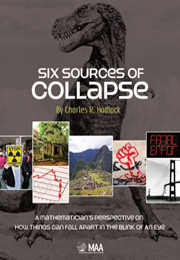 Six Sources of Collapse
Six Sources of Collapse Book contents
- Frontmatter
- Preface
- Acknowledgements
- Contents
- 1 Introduction
- 2 Predicting Unpredictable Events
- 3 Group Behavior: Crowds, Herds, and Video Games
- 4 Evolution and Collapse: Game Playing in a Changing World
- 5 Instability, Oscillation, and Feedback
- 6 Nonlinearity: Invitation to Chaos and Catastrophe
- 7 It's All About Networks
- 8 Putting It All Together: Looking at Collapse Phenomena in “6-D”
- References
- Index
- About the Author
3 - Group Behavior: Crowds, Herds, and Video Games
- Frontmatter
- Preface
- Acknowledgements
- Contents
- 1 Introduction
- 2 Predicting Unpredictable Events
- 3 Group Behavior: Crowds, Herds, and Video Games
- 4 Evolution and Collapse: Game Playing in a Changing World
- 5 Instability, Oscillation, and Feedback
- 6 Nonlinearity: Invitation to Chaos and Catastrophe
- 7 It's All About Networks
- 8 Putting It All Together: Looking at Collapse Phenomena in “6-D”
- References
- Index
- About the Author
Summary
Fire!
A famous Supreme Court opinion by Oliver Wendell Holmes once cited the example of falsely shouting “Fire!” in a crowded theater as unprotected free speech, given the well-recognized danger of an unnecessary stampede to the exits [156]. Numerous human stampedes have been documented over the years, some for false alarms, as in his example, and others for a wide variety of causes. Indeed, we've all seen headlines like these:
Death toll reaches 100 in Station Nightclub fire
Iroquois Theater fire claims 602 victims
251 trampled to death in Hajj crush
Sixty-three injured in Dutch Remembrance Day event
Deadly stampede at Yemeni political rally
95 crushed to death in Hillsborough stadium disaster
In many historic cases, the collapse of orderly egress or crowd control can be easily understood, such as with the all too common blocking of emergency exits in order to prevent unauthorized access or theft. This was the case, for example, with the Cocoanut Grove nightclub fire in Boston in 1942, which claimed almost 500 lives largely because of emergency exits that had actually been welded shut, as well as other exits that opened inward and became quickly jammed by the crush of the crowd. However, in other cases, adequate physical means for egress or crowd movement may have existed but were not well utilized. For example, in the Station Nightclub fire, there were several available emergency exits, but the panicked crowd members moved toward the doorway through which they had originally entered, which quickly became blocked by the crush.
- Type
- Chapter
- Information
- Six Sources of CollapseA Mathematician's Perspective on How Things Can Fall Apart in the Blink of an Eye, pp. 41 - 60Publisher: Mathematical Association of AmericaPrint publication year: 2012
